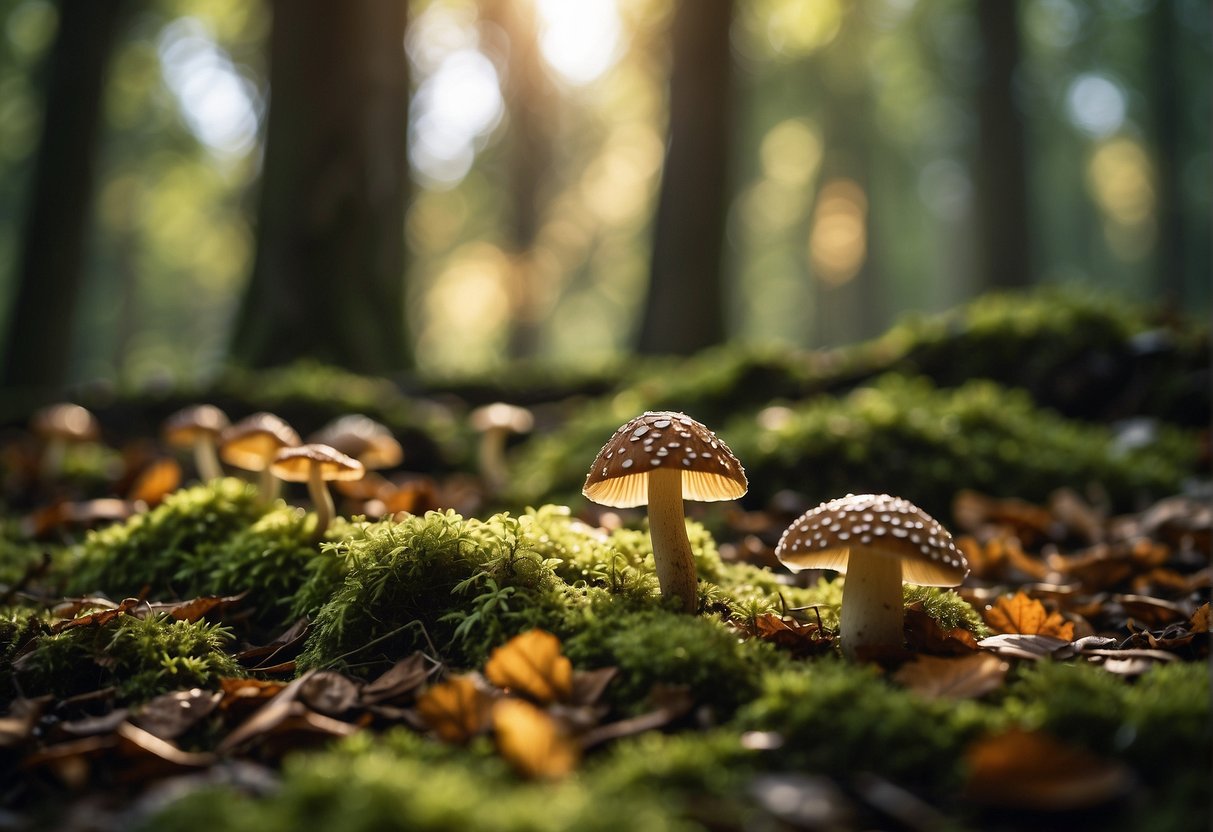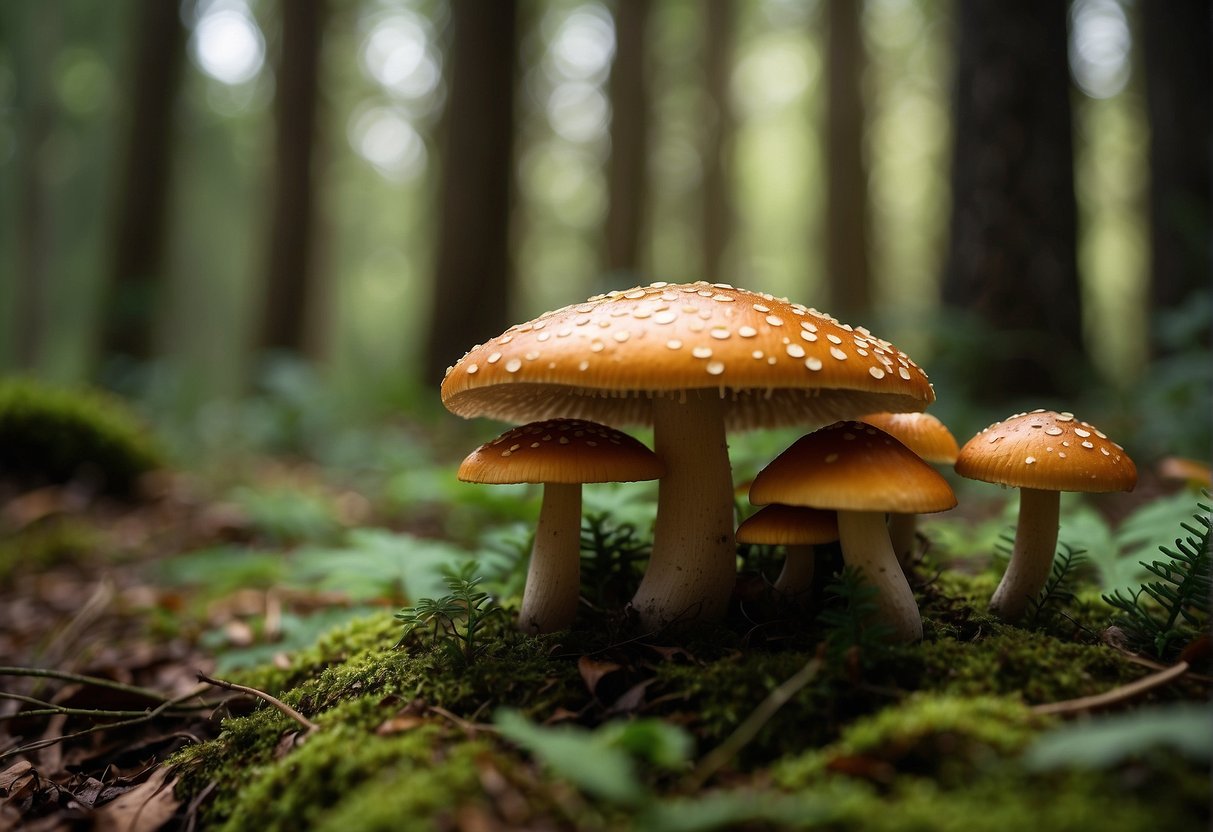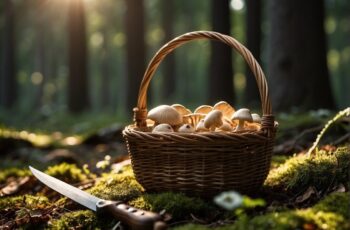Embarking on the journey to find mushrooms can be both a fascinating and rewarding outdoor activity. As you walk through the forest, your eyes scanning the ground and tree trunks, you might just discover a variety of fungi that thrive in these natural environments. Mushrooms come in an array of shapes, sizes, and colors, and hold a place of wonder in the natural world. They are not only an intriguing subject for enthusiasts but also a valuable resource for those interested in their gourmet and medicinal properties. It’s important to approach mushroom foraging with knowledge and respect, as it ensures both your safety and the preservation of ecosystems.

Before venturing out to gather your own mushrooms, it’s essential to learn about the different types that can be found in your region. Some mushrooms, like Morels, are highly sought after for their unique flavor and are often found in spring. Yet, it’s crucial to be aware that for every edible mushroom, there could be a look-alike that is potentially toxic. Therefore, understanding how to correctly identify each species is pivotal. Additionally, knowing the best times and places to look, such as on southward and westward slopes early in the mushroom season, can greatly increase your chances of a successful forage.
Gathering mushrooms also invites you to become a steward of the land. It’s your responsibility to harvest sustainably, taking only what you need and leaving the smaller or immature mushrooms to grow. Respecting wildlife and their habitats ensures that the woods remain a welcoming place for mushrooms to flourish and for fellow foragers to enjoy. Remember that the art of finding mushrooms is a dance of patience and attentiveness—you’re not only collecting these remarkable fungi but also creating a deeper connection with the natural world around you.
Mushroom Fundamentals

Before embarking on your mushroom-foraging adventure, it’s crucial to understand the basics. This knowledge is essential in distinguishing between edible and poisonous varieties, ensuring your foraging is both safe and rewarding.
Types and Characteristics
Mushrooms are a diverse group of fungi and vary widely in their characteristics. Edible mushrooms can be a delight to find, but caution is paramount as some mushrooms are poisonous. The most common types of edible mushrooms include those that fall under the category of Basidiomycota, which are characterized by their reproductive structures. You will often find these mushrooms sporting gills or pores beneath their caps, where spores are produced and released. Mushroom identification relies heavily on these features, along with color, shape, and attachment to the stem.
- Gills: Thin, blade-like structures that can be free or attached. The color of the gills can sometimes be an indicator of toxicity.
- Pores: These appear as small tubes under the mushroom cap. The shape and size of the pores can help in identifying the species.
Mushroom Habitats
Different mushrooms thrive in various environments, and your foraging will depend largely on these habitats. Woodlands are often fertile grounds for mushrooms, particularly areas with hardwood trees like oak or maple. Conversely, coniferous forests can host different types of fungi suited to their unique conditions.
- Hardwood areas: Seek out mushrooms near trees such as elms, ashes, and aspens.
- Coniferous regions: Keep your eyes peeled for mushrooms growing around pine, fir, and spruce.
Remember, your safety is paramount, so always be sure of a mushroom’s identity before considering it as an addition to your basket.
Identifying Edible Mushrooms
When you’re out in the wild or even your local forest, knowing how to spot safe and beneficial mushrooms can enhance both your foraging experience and your meals. Let’s learn how to distinguish the best from the rest.
Common Edible Species
Edible mushrooms come in a variety of shapes and sizes. Familiarize yourself with some local favorites like the Button Mushroom (Agaricus bisporus), prized for its versatility and mild flavor. The Chanterelle is distinguished by its trumpet-like shape and peachy color, offering a slightly fruity taste. Oyster Mushrooms have a soft, delicate shape with a side growth pattern and bring a subtle, anise-like essence to dishes. The Portobello Mushroom, essentially a mature Button Mushroom, is renowned for its meaty texture, while the Shiitake Mushroom is recognized by its umbrella-shaped brown cap with a rich, buttery flavor. Lastly, Morels, with their unique honeycombed appearance, are a sought-after seasonal delight for their nutty taste.
Identification Techniques
Mastering mushroom identification can be complex, but focusing on a few key features can make it easier. Examine the structures under the cap: most edible mushrooms have gills, pores, or spines where spores are produced. For example, Shiitake Mushrooms feature visible gills, while Morels exhibit a porous surface. Always carry a guidebook or use identification apps with pictures to compare your findings. Ensure the colors and shapes match the species you suspect, and when in doubt, take a spore print for further verification. Look also for signs of attachment to wood or the ground as different species have different growth sites.
Safety and Toxicity
Safety first: do not consume any mushrooms unless you are absolutely certain of their identity. Some edible mushrooms can have dangerous look-alikes, such as those from the deadly Amanita family which is notorious for its resemblance to safe species. Eating the wrong mushroom can result in severe toxicity or even be fatal. Take note of the color, size, and location, but also check for tell-tale signs of toxicity such as a red color on the cap or stem, which is often a red flag. Be aware of the health benefits but also the potential risks of foraging mushrooms, and consider bringing an experienced forager with you to double-check your findings. Your safety is paramount, so err on the side of caution to enjoy mushroom foraging without the hazards.
Mushroom Foraging Tips
When embarking on a mushroom foraging journey, it’s crucial to grasp best practices and understand how to preserve your finds to enjoy them safely.
Best Foraging Practices
To ensure a successful forage, start by seeking out ideal mushroom habitats such as oak or beech forests where leaf litter and abundant organic matter create a rich environment for growth. When searching garden areas or lawns, focus on spots with high organic content, especially during the fruitful late summer months.
- Plan Your Trip: Late summer to early fall is the prime time for mushroom abundance.
- Safety First: Never consume a mushroom unless you’re 100% sure it’s edible. Use a trusted field guide to identify species.
- Respect the Habitat: Forage in a way that minimizes impact. Avoid damaging the mycelium by cutting mushrooms at the stem rather than pulling them out.
Bioluminescent fungus, known for its mesmerizing glow, adds a unique twist to night foraging. Exercise caution, however, as some glowing varieties are not edible.
Mushroom Preservation
Once you’ve gathered your mushrooms, preserving their savory flavor and texture is key for later enjoyment. Techniques vary depending on the type and intended use.
- Drying: Perfect for long-term storage. Spread mushrooms on a rack in a dry, airy space.
- Refrigerating: Store fresh mushrooms in a paper bag inside the fridge for short-term use.
Remember, the edible dancing mushroom is known for its delicate taste, so preserve them with care to maintain their distinct savory qualities.
By following these tips, your foraging ventures are more likely to be safe, responsible, and rewarding. Enjoy the bounty that nature provides and always forage with respect for the environment.
Unusual Mushroom Varieties

While trekking through coniferous woodlands or wandering in local forests, it’s possible to stumble upon a world of unusual mushrooms, some of which are highly sought after for their unique flavors and textures.
Unique Species Overview
You might already be familiar with the golden-hued chanterelle mushrooms, but have you had the pleasure of discovering the matsutake? Matsutakes are a prized Japanese delicacy, their value stemming not only from their distinctive spicy aroma but also their rarity due to their specific symbiotic relationship with trees. Equally elusive are the morel mushrooms, with their sponge-like appearance, which are foraged widely in the spring.
In the realm of the unique, the amanita stands out with its often bright colors and association with fairy tales. However, while striking, many amanitas are toxic, and it’s crucial to be able to identify these accurately. On the other hand, the porcini mushroom, a staple in Italian cuisine, is beloved for its nutty flavor and meaty texture. When hunting for porcinis, look for their stout stems and rounded brown caps in hardwood forests.
Rare and Remarkable
Let’s talk about rarities. The cauliflower mushroom resembles marine coral and offers a crisp, earthy taste that truly stands out. Not far behind in uniqueness is the elfin saddle, a peculiar creature, which not only has an eccentric appearance but is also edible. The gypsy mushroom, considered rare in some regions, adds an almond-like fragrance to your foraged bounty.
Have you ever noticed mushrooms with vibrant colors in the woods? The indigo milk cap leaks a blue milk when cut, a sight that’s as unusual as it is enchanting. Then there’s the lactarius family – some members, like the bleeding tooth, exhibit dramatic red “bleeding,” while the amethyst deceiver delights with its deep violet hues.
The veiled lady mushroom, a variety of stinkhorn, boasts an impressive lacy skirt. While not commonly eaten, its structure is a marvel to behold. Those adept at mushroom identification might also find turkey tail mushrooms with their distinctive multi-colored concentric circles – these are known more for their medicinal properties than culinary uses.
Within the dark, damp woods, the brain mushroom, often confused with the poisonous false morel, demands a knowledgeable forager. Remember, certainty in identification is your best friend. Equally curious are puffballs, ranging from small to gigantic, waiting to release their spores into the air with a satisfying ‘poof’ when mature.
Lastly, the stinkhorns, with their unforgettable odor and sticky spore mass, might not be your typical target, but you can’t deny their peculiar charm. Whether you’re searching for a culinary treasure or simply enjoying the diversity of fungal life, the unusual varieties you find are as fascinating as they are diverse. Happy foraging!


